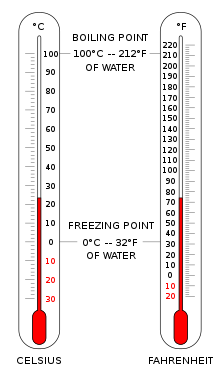顯熱
外觀
顯熱是指物體或熱力學系統中造成溫度改變的熱量交換;這種熱交換會改變物體或系統的某些宏觀變量,但物體或系統的其它宏觀變量保持不變,例如體積或壓力。 [1] [2] [3] [4]
用法
[編輯]

顯熱與潛熱相反,潛熱是隱藏的熱交換量,也就是在不改變溫度的情況下發生。例如,在冰融化成水的相變期間,系統的溫度恆定,直到所有冰融化為止。
熱力學過程中的顯熱可以計算為物體質量( m )與比熱容( c )和溫度變化()的乘積。
顯熱和潛熱不是特殊的能量形式。相反,它們描述了在根據其對材料或熱力學系統的影響而指定的條件下進行的熱交換。
早期研究熱力學的科學家的著作中,顯熱由量熱法明確定義。詹姆斯·普雷斯科特·焦耳(James Prescott Joule)於1847年將其描述為溫度計指示的能量。 [5]
在自然界中傳輸能量時,在許多過程中都觀察到了感熱和潛熱。潛熱與在恆定溫度下測量的狀態變化有關,尤其是大氣中水蒸氣的相變,主要是汽化和冷凝,而顯熱直接影響大氣的溫度。
參考資料
[編輯]- ^ Partington, J.R. (1949). An Advanced Treatise on Physical Chemistry, Volume 1, Fundamental Principles. The Properties of Gases, Longmans, Green, and Co., London, pages 155-157.
- ^ Prigogine, I., Defay, R. (1950/1954). Chemical Thermodynamics, Longmans, Green & Co, London, pages 22-23.
- ^ Adkins, C.J. (1975). Equilibrium Thermodynamics, second edition, McGraw-Hill, London, ISBN 0-07-084057-1, Section 3.6, pages 43-46.
- ^ Landsberg, P.T. (1978). Thermodynamics and Statistical Mechanics, Oxford University Press, Oxford, ISBN 0-19-851142-6, page 11.
- ^ J. P. Joule, The Scientific Paper of James Prescott Joule, The Physical Society of London: 274, 1884,
I am inclined to believe that both of these hypotheses will be found to hold good,—that in some instances, particularly in the case of sensible heat, or such as is indicated by the thermometer, heat will be found to consist in the living force of the particles of the bodies in which it is induced;
, Lecture on Matter, Living Force, and Heat. May 5 and 12, 1847


